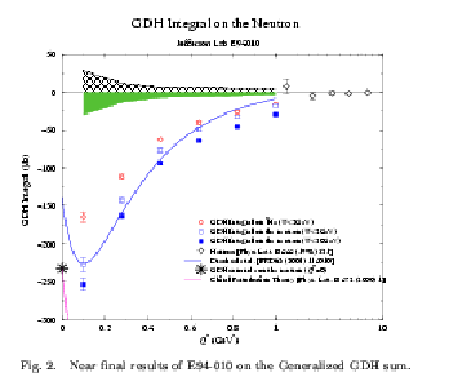DEFINITIONS AND REVIEW OF CURRENT DATA

The Gerasimov-Drell-Hern (GDH)
sum rule is of fundamental importance to our understanding of the
nucleon. It is based on some very general principles of physics
including Lorentz and Gauge
invariance, cross symmetry, causality and unitarity thereby making it
model independent. It's 1/ν
weighting make the lower lying resonances most important. Additionally
the connection between the
GDH sum rule at low Q2 and the Ellis-Jaffe sum rule in the
deep inelastic region is of great
interest.
The actual GDH sum rule was derived at Q2=0 (for real
photons):

Where ν is the photon energy, νth is the
photo-absorption threshold, M is the nucleon mass and σ1/2
and
σ3/2 are the absorption cross sections for total helicity
1/2 and 3/2.
At Q2 different from 0 one can define the polarized
structure functions g1 and g2.

Here x0=Q2/2Mν0 and K is the flux
factor of vitual photons &nu &radic 1+&gamma2 , and γ2 = Q 2/ ν2.
This reduces to the GDH sum rule for Q2=0.
In the DIS limit the integral becomes.

Here Γ is the first momentum of g1.
Studying the GDH sum rule at various Q2 allows us to
investigate the question of the transition from
the high Q2 to the low Q2 regimes.
The change of signs that occurs in the region 0 < Q2
< 1 GeV2 is parcicularily puzzling.

PROTON AND NEUTRON DATA
There are 4 major Q2 regions of interest.
- High Q2
- Experimental Data
- Phenomenological Parametrizations
- Intermediate Q2
- Experimental Data
- Phenomenological Parametrizations
- Burkert and Ioffe
- Close et. al.
- Low Q2
- Experimental Data
- Phenomenological Parametrizations
- Soffer and Teryaev
- Bianchi and Thomas
- Q2 = 0

NEUTRON DATA

- Jaideep's Data (Q2 >0)
- Recent data (Jlab, Hermes)

DISCUSSION (in progress ...)
- An introduction to the GDH Sum Rule was first given by S.L..
We first discussed the meaning of the sum rule, the kinematical variables,
their range and all that.
- We came up with the material posted above.
- The main issue is: the extended GDH sum rule, I(Q2) --
the sum rule
at varying Q2 -- is positive
at large Q2, because
it is related to the first moment of g1.
On the other side,
I(Q2=0) is
negative . There must be a point
where I(Q2)
changes sign, or, in other words, I(Q2) does not extrapolate smoothly to the low Q2 region, as predicted
by pQCD, but a dramatic Q2 dependence appears.
The investigation of this point is of particular interest for
understanding the transition between the perturbative and
non-perturbative regimes of QCD.
- A number of open questions remain:



![]()
